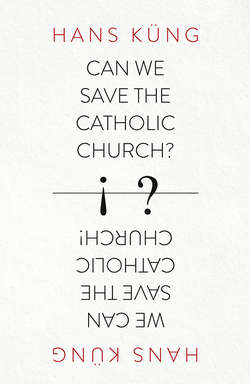Can We Save the Catholic Church?

Реклама. ООО «ЛитРес», ИНН: 7719571260.
Оглавление
Hans Kung. Can We Save the Catholic Church?
Note on the Present English Edition
The Cause of the Illness
Physician, not Judge
The Church Cannot Go On in This Way
Decline of Church Institutions
The Failed Restoration Policies of Two Popes
The Transition from a ‘Wintry’ Church to a Gravely Ill Church
Attacks of Fever
The First Fever Attack: Police Investigation of Bishops
The Second Fever Attack: The Vatican Called to Account
The Third Fever Attack: Exposure of Financial Scandals in the Vatican
The Fourth Fever Attack: Conflicts within the Top Echelons of Church Leadership
The Fifth Fever Attack: The Flurry of Excitement about Condoms
Seven Reactions to the Illness of the Church
Bishops Prepared to Enter into a Dialogue
Bishops Refusing to Enter into a Dialogue
Diagnosis and Therapy
Medically Assisted Suicide or Reanimation?
A Case History of the Church’s Pathology
Is Tradition or Progress the Criterion of Truth?
Christian Churches Need to Be More Christian
An Ominous Snapshot
The Other Church
1. Peter – the First Pope? Anamnesis
First Diagnosis
2. Early Assertions of the Roman Claim to Primacy. Anamnesis
Second Diagnosis
3. The First True Pope and His Rome-centred Ideology. Anamnesis
Third Diagnosis
4. Erring Popes, Papal Forgeries and Papal Proceedings. Anamnesis
Fourth Diagnosis
5. Unholy Fathers and Reforms. Anamnesis
Fifth Diagnosis
6. From the Roman Principle to the Roman System. Anamnesis
Sixth Diagnosis
7. The Roman System Splits the Unity of Christendom
Anamnesis
Seventh Diagnosis
How Can This Open Wound Be Healed?
1. Roman Monopoly of Power and Truth. The Findings: The Pope as an Absolutist Monarch, the Papal Church as Mother
The Therapy: Instead of an Absolute Primacy of Domination and Rule, a Pastoral Primacy of Service
2. Juridicism and Clericalism. Findings: The Church Becomes a Juridical and Clerical Institution
Therapy: Instead of Hierarchy and Domination, a Community in Freedom, Equality and Brotherhood/Sisterhood
3. Hostility to Sexuality and General Misogyny. Findings: Denigration of Sexuality and Marriage
Therapy: Renounce the Augustinian Doctrine of Original Sin, Abolish the Law of Celibacy and Improve the Status of Women
4. Propensity to Violence and Crusader Mentality. Findings: Theological Vindication of the Use of Force and of War
Therapy: Instead of Violence and Crusades, Bearing the Cross in Daily Life
5. Reversal of Papal Worldly Power into Papal Impotence. Findings: Collapse of Political Power and Monetization of the System
Therapy: Reform of the Head and the Branches
6. Refusal to Reform. Findings: All Attempts at Reform Failed
7. The Reformation: a Radical Answer to the Church’s Unwillingness to Reform
Therapy: Take Luther’s Demands for Reform Seriously
A Severely Ill Patient in Need of Rehabilitation
A Pretence of Rehabilitation: the Council of the Counter-Reformation
Retreat into a Parallel World of Its Own Making, Shut off from the Modern World
The First Virus: Church Hostility to Science
The Relapse: Charles Darwin
The Second Virus: Church Hostility to Progress
The Relapse: The Pill and the Campaign Against Modern Medical Techniques
The Third Virus: Church Hostility to Democracy
The Relapse: Preference for Authoritarian Regimes
The Fourth Virus: The Roman Catholic Enthusiasm for Restoration
The Relapse: an Index of Prohibited Books to Dull People’s Minds
The Roman System Mounts a Frontal Attack on the Modern Age
The Relapse: Rome and Communist China
A Medical Analysis Only Applicable to the Western World?
How Can We Save the Catholic Church? Between Modernism and Anti-Modernism
Pius XII – a Holy Pope?
Reinvigorating the Church: John XXIII
Two Successful Paradigm Shifts Initiated by the Second Vatican Council
Restoration Rather than Renewal: Paul VI
Relapse into a Pre-conciliar Constellation: John Paul II
‘Santo Subito’? Maciel, Miracles and Inflationary Increase of Saints
Why the Bishops Maintain Their Silence
Enforced Conformity of the Episcopate
How to Have a Successful Career Modo Romano
The Church is a Façade
The New Testament Mission to Rehabilitate the Church Leadership
Three Petrine Promises – Three Papal Temptations
Osteoporosis of the Church System?
Authoritarian Systems Can Implode
The Norm for Church Reform Is Not Any Canon Law Fabricated by the Church, but the Historical Jesus Christ as Testified to in the Bible
The Church Should Concentrate on Its Core Functions and at the Same Time Face Up to Its Social Responsibilities
The Pope Must Strive to Maintain Community with the Church
The Roman Curia Should Not Be Destroyed, But It Should Be Reformed in Accordance with the Gospel
Competent Expert Staff Appointments Instead of Cronyism
Glasnost and Perestroika (Openness and Restructuring) for the Church Finances
Abolish the Inquisition, Don’t Just Reform It
Eliminate All Forms of Repression in the Church
Canon Law Needs to Be Completely Remodelled, Not Just Improved
Changes that Betray the Spirit of the Council
Omissions That Betray the Spirit of the Council
Allow Priests and Bishops to Marry
Open Up All Church Offices to Women
Include Clergy and Lay People in the Election of Bishops Again
No More Restrictions on Joint Celebrations of the Eucharist by Catholic and Protestant Christians
Truthful Ecumenical Understanding and Collaboration, with No Excuses and No Secrets
Compulsory Therapy?
A Prospect for Convalescence
Books by Hans Küng
Books by Other Authors
Отрывок из книги
COVER
TITLE PAGE
.....
But this is just another symptom of the dramatic loss of confidence the Catholic Church is facing. According to a study by the Allensbach Institute published in July 2010:
… the percentage of the general population that believes the Church to be capable of offering orientation on questions of morality has dropped from 35 per cent in 2005 to 23 per cent; between March and June 2010 alone it decreased from 29 per cent to 23 per cent. At the same time, the belief that the Church offers answers in the search for meaning has also declined. In 2005, around 50 per cent of the population still believed that; by March 2010 the figure was only 45 per cent, in June it was down to 38 per cent. (Frankfurter Allgemeine, 23 June 2010)
.....